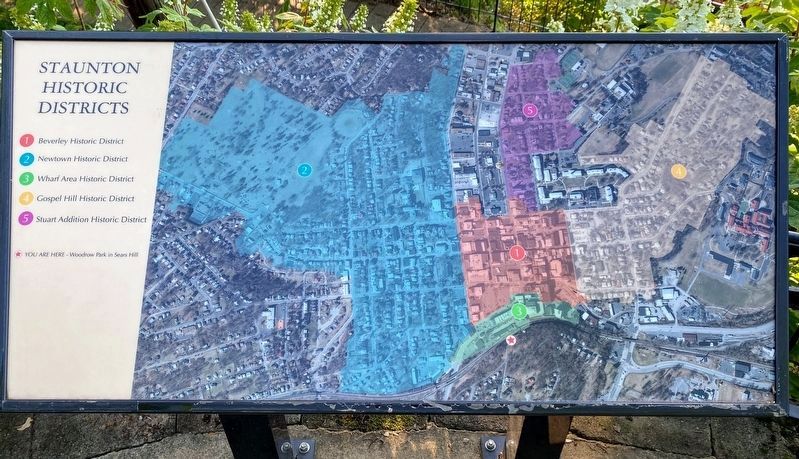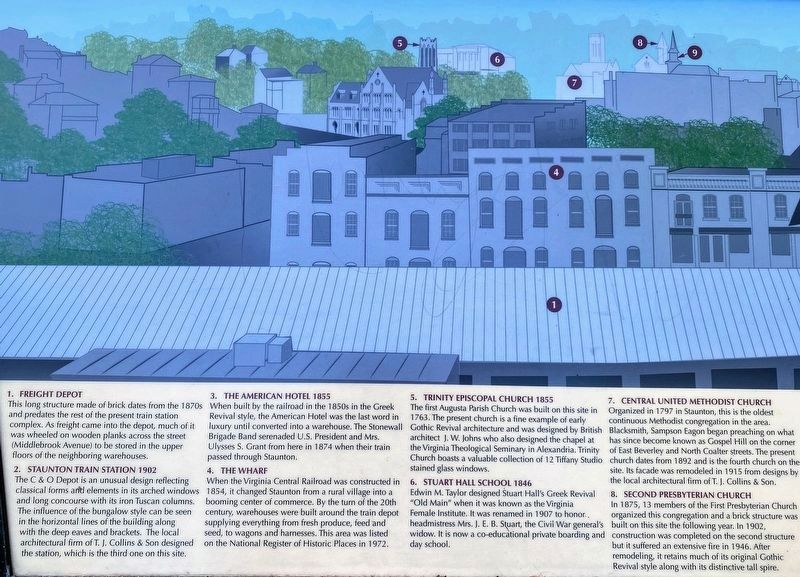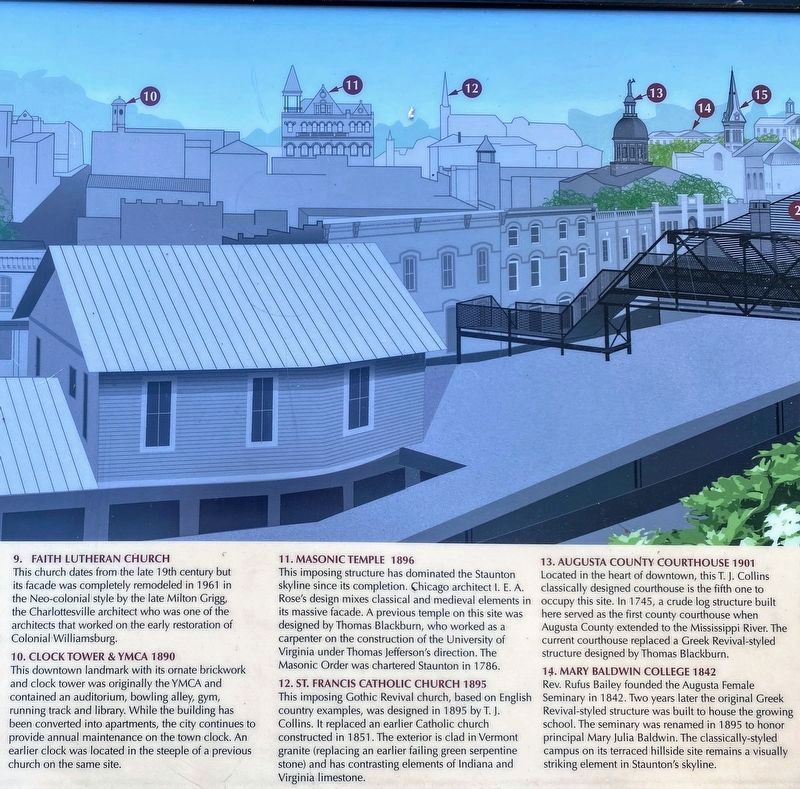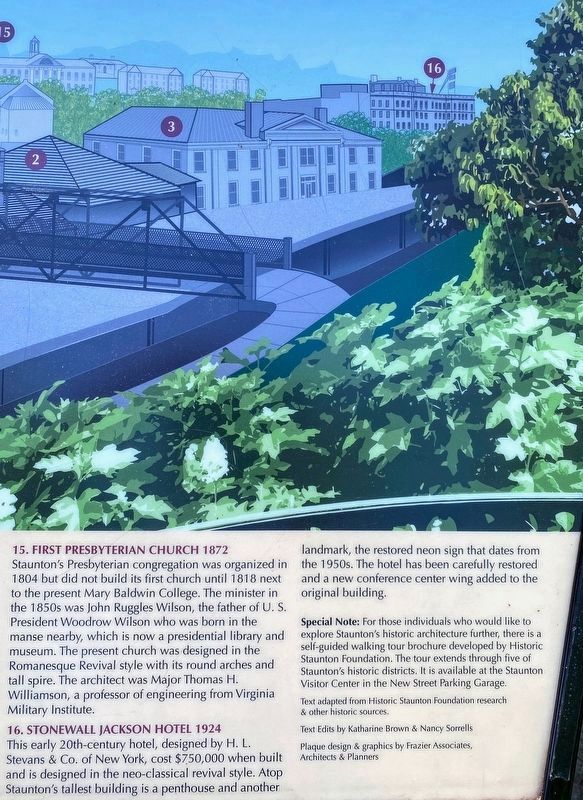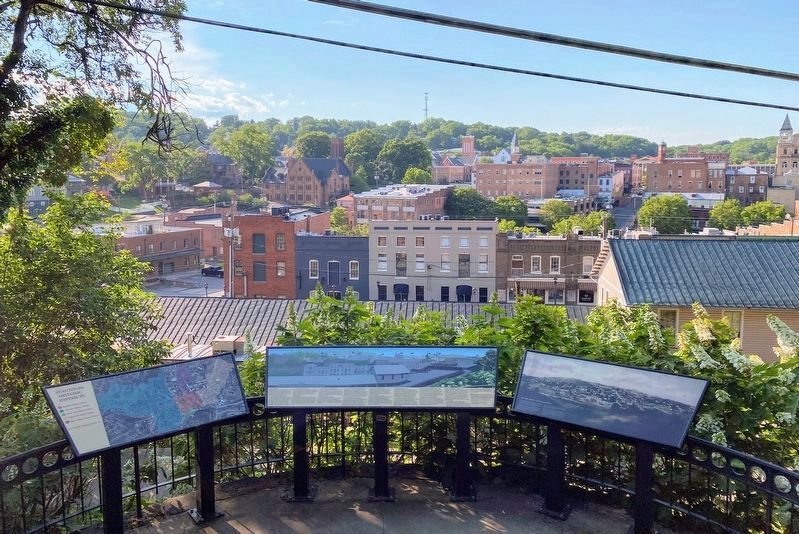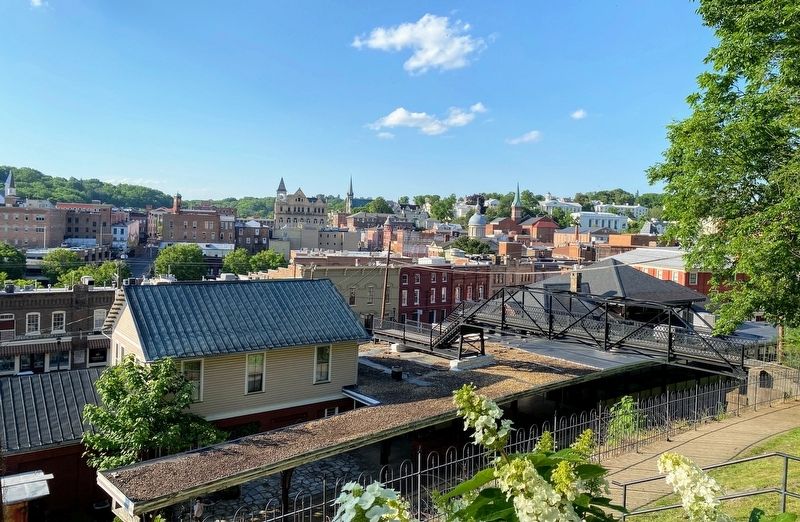Staunton Historic Districts
Staunton Historic Districts
1 Beverley Historic District
2 Newtown Historic District
3 Wharf Area Historic District
4 Gospel Hill Historic District
5 Stuart Addition Historic District
* You Are Here - Woodrow Park in Sears Hill
(center panel)
1. Freight Depot
This long structure made of bricks dates from the 1870s and predates the rest of the present train station complex. As freight came into the depot, much of it was wheeled on wooden planks across the street (Middlebrook Avenue) to be stored in the upper floors of the neighboring warehouses.
2. Staunton Train Station 1902
The C&O Depot is an unusual design reflecting classical forms and elements in its arched windows and long concourses with its iron Tuscan Columns. The influence of the bungalow style can be seen in the horizontal lines of the building along with the deep eaves and brackets. The local architectural firm of T. J. Collins & Son designed the station, which is the third one on this site.
3. The American Hotel 1855
When built by the railroad in the 1850s in the Greek Revival style, the American Hotel was the last word in luxury until converted into a warehouse. The Stonewall Brigade Band serenaded U.S. President and Mrs. Ulysses S. Grant
4. The Wharf
When the Virginia Central Railroad was constructed in 1854, it changed Staunton from a rural village into a booming center of commerce. By the turn of the 20th century, warehouses were built around the train depot supplying everything from fresh produce, feed and seed, to wagons and harnesses. This area was listed on the National Register of Historic Places in 1972.
5. Trinity Episcopal Church 1855
The first Augusta Parish Church was built on this site in 1763. The present church is a fine example of early Gothic Revival architecture and was designed by British architect J.W. Johns who also designed the chapel at the Virginia Theological Seminary in Alexandria. Trinity Church boasts a valuable collection of 12 Tiffany Studio stained glass windows.
6. Stuart Hall School 1846
Edwin M. Taylor designed Stuart Hall's Greek Revival "Old Main" when it was known as the Virginia Female Institute. It was renamed in 1907 to honor headmistress Mrs. J.E.B. Stuart, the Civil War general's widow. It is now a co-educational private boarding and day school.
7. Central United Methodist Church
Organized in 1797 in Staunton, this is the oldest continuous Methodist congregation in the area. Blacksmith, Sampson Eagon began preaching on what has since become known as Gospel Hill on the corner of East Beverly and North Coalter streets. The present church dates from 1892 and is the fourth church on the site. Its facade was remodeled in 1915 from designs by the local architectural firm of T.J. Collins & Son.
8. Second Presbyterian Church
In 1875, 13 members of the First Presbyterian Church organized this congregation and a brick structure was built on this site the following year. In 1902, construction was completed on the second structure but it suffered an extensive fire in 1946. After remodeling, it retains much of its original Gothic Revival style along with its distinctive tall spire.
9. Faith Lutheran Church
This church dates from the late 19th century but its facade was completely remodeled in 1961 in the Neo-colonial style by the late Milton Grigg, the Charlottesville architect who was one of the architects that worked on the early restoration of Colonial Williamsburg.
10. Clock Tower & YMCA 1890
This downtown landmark with its ornate brickwork and clock tower was originally the YMCA and contained an auditorium, bowling alley, gym, running track and library. While the building has been converted into apartments, the city continues to provide annual maintenance on the town clock. An earlier clock was located in the steeple of a previous church on the same site.
11. Masonic Temple 1896
This imposing structure has dominated the Staunton skyline since its completion. Chicago architect I.E.A. Rose's design mixes classical and medieval elements in its massive facade. A previous temple on this site was designed by Thomas Blackburn, who worked as a carpenter on the construction of the University of Virginia under Thomas Jefferson's direction. The Masonic Order was chartered Staunton in 1786.
12. St. Francis Catholic Church 1895
This imposing Gothic Revival church, based on English country examples, was designed in 1895 by T.J. Collins. It replaced an earlier Catholic church constructed in 1851. The exterior is clad in Vermont granite (replacing an earlier failing green serpentine stone) and has contrasting elements of Indiana and Virginia limestone.
13. Augusta County Courthouse 1901
Located in the heart of downtown, this T.J. Collins classically designed courthouse is the fifth one to occupy this site. In 1745, a crude log structure built here served as the first county courthouse when Augusta County extended to the Mississippi River. The current courthouse replaced a Greek Revival-styled structure designed by Thomas Blackburn.
14. Mary Baldwin College 1842
Rev. Rufus Bailey founded the Augusta Female Seminary in 1842. Two years later the original Greek Revival-styled structure was built to house the growing school. The seminary was renamed in 1895 to honor principal Mary Julia Baldwin. The classically-styled campus on its terraced hillside site remains a visually striking element in Staunton's skyline.
15. First Presbyterian Church 1872
Staunton's Presbyterian congregation was organized in 1804 but did not build its first church until 1818 next to the present Mary Baldwin College. The minister in the 1850s was John Ruggles Wilson, the father of U.S. President Woodrow Wilson who was born in the manse nearby, which is now a presidential library and museum. The present church was designed in the Romanesque Revival style with its round arches and tall spire. The architect was Major Thomas H. Williamson, a professor of engineering from Virginia Military Institute.
16. Stonewall Jackson Hotel 1924
This early 20th-century hotel, designed by H.L. Stevans & Co. of New York, cost $750,000 when built and is designed in the neo-classical revival style. Atop Staunton's tallest building is a penthouse and another landmark, the restored neon sign that dates from the 1950s. The hotel has been carefully restored and a new conference center wing added to the original building.
Special Note: For those individuals who would like to explore Staunton's historic architecture further, there is a self-guided walking tour brochure developed by Historic Staunton Foundation. The tour extends through five of Staunton's historic districts. It is available at the Staunton Visitor Center in the New Street Parking Garage.
Text adapted from Historic Staunton Foundation research & other historic sources.
Text Edits by Katharine Brown & Nancy Sorrells
Plaque design & graphics by Frazier Associates, Architects & Planners
Erected 2016 by Friends of the Sears Hill Bridge Committee.
Topics. This historical marker is listed in this topic list: Architecture.
Location. 38° 8.814′ N, 79° 4.375′ W. Marker is in Staunton, Virginia, in Augusta County. Marker can be reached from Middlebrook Avenue (Virginia Route 252) west of South Augusta Street, on the left when traveling south. Located on Sears Hill in Woodrow Park. The marker can be reached from the north via a footbridge behind Staunton Station. Alternatively, the marker can be reached from the south via a pedestrian walkway north of Sears Hill Road & Winthrop Street. Touch for map. Marker is at or near this postal address: 36 Middlebrook Ave, Staunton VA 24401, United States of America. Touch for directions.
Other nearby markers. At least 8 other markers are within walking distance of this marker. Beyer Print of Staunton (here, next to this marker); Barnas Sears, Woodrow Park, & Sears Hill Neighborhood
Credits. This page was last revised on June 10, 2021. It was originally submitted on June 10, 2021, by Shane Oliver of Richmond, Virginia. This page has been viewed 414 times since then and 57 times this year. Photos: 1, 2, 3, 4, 5, 6. submitted on June 10, 2021, by Shane Oliver of Richmond, Virginia. • Bernard Fisher was the editor who published this page.
